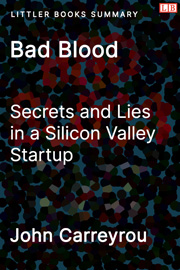Book Description
A true story of the rise and fall of Theranos, a billion-dollar healthcare startup.
If You Just Remember One Thing
Elizabeth Holmes built a $9 billion company (Theranos) based on a rapid blood-testing technology that didn't wor... More
Bullet Point Summary and Quotes
- Elizabeth Holmes, who feared needles and wanted to be a billionaire since age 10, conceived the idea for a machine to revolutionize medical diagnoses.
- In 2004, she founded Theranos (originally named Real-Time Cures) with Stanford colleague Shaunak Roy to develop a wearable patch using microneedles to test blood, but they realized microneedles couldn't draw enough blood.
- Theranos pivoted to making a credit card-sized device to draw blood using a pinprick. The results would then be fed to a toaster-sized machine and it would test for over 200 diseases. The device would be cheap and portable. Holmes envisioned the device in every home. They called this device Edison.
- There were many technical hurdles they weren't able to clear, including:
- It was impossible to test for more than 80 diseases with such a small blood sample size.
- The sample became increasingly diluted during the testing process, making the results inaccurate.
- Edison was temperature sensitive. It might be inaccurate in different climates.
- The pipettes clogged often and required specialists to fix.
- Despite shortcomings, Holmes effectively used the media spotlight to hype Edison.
- She resembled the female Steve Jobs -- wore black turtlenecks, deepened her voice, and used the same ad agency that Apple used.
- "Like her idol Steve Jobs, she emitted a reality distortion field that forced people to momentarily suspend disbelief."
- The technology seemed disruptive and promising. Investors were scared to miss out.
- "By positioning Theranos as a tech company in the heart of the Valley, Holmes channeled this fake-it-until-you-make-it culture, and she went to extreme lengths to hide the fakery."
- "Elizabeth was so persuasive. She had this intense way of looking at you while she spoke that made you believe in her and want to follow her."
- By 2014, Theranos reached a $9B valuation, had global deals with Walgreens and Safeway.
- Theranos boasted higher accuracy than competitors despite a 65% failure rate. Some key tests like testosterone failed 87% of the time.
- Theranos lied continuously to investors and government agencies about its capabilities. When Theranos demonstrated the Edison, they secretly ran the tests on other machines and pretended the results came from Edison.
- Sometimes the Edison would be completely nonfunctional and Theranos would simply display made-up results.
- Theranos inappropriately excluded outliers to make the data fit their needs.
- Theranos went to great lengths to deceive people about FDA status and avoid FDA scrutiny. It claimed Edison was an informational tool and not a medical device to evade regulation. Theranos also cherry-picked the few tests that could pass FDA approval to publicly boast and pretended to advocate for more FDA regulation. This generated publicity while hiding lack of comprehensive approval.
- Theranos provided unreliable data to many real patients, which has serious medical consequences.
- Theranos experienced high employee turnover as staff resigned over the company's dishonesty. Many were replaced by Indian employees who were dependent on the company for their visas.
- Staff were forced to sign NDAs to prevent leaks, some were threatened and monitored by private investigators.
- Toxic culture took a toll on employees' mental health. Ian Gibbons, the chief scientist at Theranos who worked there for ten years, was demoted for questioning the company's practices. Gibbons committed suicide two months later, the night before he was scheduled to be deposed in a lawsuit related to Theranos.
- The author and his sources faced threats and harassment, but still went forward to expose Theranos.
- After evidence of Therano's malpractices surfaced, partnerships were dropped and more litigations ensued.
- The company was dissolved on September 4, 2018, months after this book was first published. Holmes and former company president Sunny Balwani were found guilty of fraud. Holmes was sentenced to 11 years and 3 months in prison. Balwani was sentenced to 12 years and 11 months in prison and 3 years of probation. Holmes and Balwani were also ordered to jointly pay $452 million to the victims of the fraud.
Bad Blood: Resources
- Download this summary and 173+ other top nonfiction book summaries in one book (PDF, eBook, DOCX)
- Buy the book
